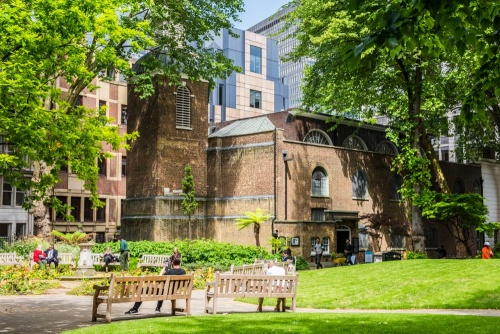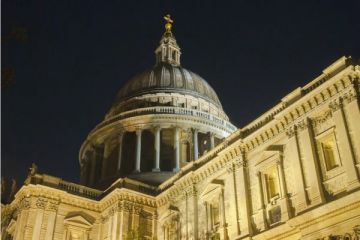
Tucked into a leafy corner of Postman's Park in London's Barbican district stands the historic church of St Botolph (more often known as St Botolph's-without-Aldersgate to distinguish it from other London churches dedicated to the same saint).
History
This was one of four medieval London churches dedicated to Botolph, or Botwulf, a 7th-century East Anglian saint. Botolph was considered the patron saint of travellers in the days before St Christopher took over that role, so it comes as no surprise that each of the churches stood near one of London's city gates.
One church stood at Billingsgate, one at Aldgate, one at Bishopsgate, and this one at Aldersgate. You can see a blue plaque on St Martin's Le Grand commemorating the site of the Aldersgate gateway, which was pulled down in 1761.

St Botolph's, Billingsgate was lost in the Great Fire of London in 1666 and was never rebuilt The other three churches still stand; St Botolph-without-Bishopsgate (ie. outside Bishopsgate), St Botolph's Aldgate (sometimes called St Botolph's-without-Aldgate), and this church, St Botolph-without-Aldersgate.
Historians believe that the first church on this spot was erected around 1050, but the first written record of it comes in 1291 and the first record of a rector does not come until 1333. That Saxon church was rebuilt in the 14th century and remarkable escaped the Great Fire unharmed.
What the Great Fire could not accomplish, the passage of time did, and by the middle of the 18th century the church was in a very poor state. The church was almost completely rebuilt starting in 1789; only the east wall was retained from the medieval building. The exterior restoration was the work of Nathaniel Wright, while Nathaniel Evans was responsible for the interior we see today.
The new church was built primarily of brick, with a slender bell tower at the west end built on the walls of its medieval predecessor.

In 1831 increasing traffic on Aldersgate Street meant that the street had to be widened. The only way to accomplish this was to shorten the east end of the church. The entire east front was torn down and the building shortened to give us the rather unusually proportioned church we see today.
The east facade, looking onto Aldersgate Street, is at odds with the rest of the building. It is faced with Roman cement with four attached Ionic columns flanking a large Venetian window.
Historical Highlights
One of the highlights of St Botolph's is the east window, painted by James Pearson in 1788. The window depicts Jesus in the Garden of Gethsemane. It was originally flanked with two smaller windows by the same artist but these were destroyed by bombing in WWII and replaced with modern windows. The original central window is the only painting on glass to survive in the City of London.
The bulk of the remaining glass is Victorian and of a very high standard. Look for the four windows in the lower section of the south aisle. These windows illustrate key events in the area's history. One scene shows James I entering the City of London by Aldersgate in 1618. The window is given by the Worshipful Company of Ironmongers in recognition of St Botolph's as their guild church.

Another window depicts Henry Compton, Bishop of London, giving refuge to Princess Anne (later Queen Anne) in his residence of London House, near Aldersgate, during the Glorious Revolution of 1688.
Another window shows John Wesley preaching in Moorfields. Wesley and his brother Charles had a moment of spiritual awakening while living near St Botolph's in 1738.
The interior is an exquisite example of Georgian style, with wooden galleries on three sides, supported by square columns. The east end terminates in a semi-circular domed apse. The ceiling boasts beautifully detailed plasterwork. The organ, located in the west gallery, dates to 1788 and was made by Samuel Green.

Only a few memorials survive from the medieval church. The oldest is that of Anne Packington (d 1563). Other memorials of note include Elizabeth Ashton (d 1662) and Elizabeth Richardson (d 1639). Then there is a poignant memorial to Elizabeth Smith, who died in 1750 at just 15 years old. The memorial is topped by a row of the skulls, a traditional symbol of mortality.
The most famous person buried here, however, is Sir John Micklethwaite (1612-1682). Micklethwaite was the son of the rector of Cherry Burton in Yorkshire. He studied medicine in Europe and was appointed an assistant physician at St Bartholomew's Hospital in London, serving under Dr John Clarke. He married Clarke's daughter and in 1653 he was raised to the level of physician.
He became president of the College of Physicians in 1676. When Charles II fell ill in 1681 Micklethwaite cured him and was knighted by the king in gratitude. He served as a physician in ordinary to the king but died the following year and was buried at St Botolph's-without-Aldersgate.

By the Victorian period St Botolph's churchyard, like all London churches, was crowded with burials, and ew interments were banned. In 1880 St Botolph's churchyard was combined with the churchyards of St Leonard, Foster Lane and Christchurch, Newgate Street to form Postman's Park, so-named because it was a popular place for workers at the General Post Office on St Martin's Le Grand to relax. Old gravestones from the former burial ground line the park walls.
Across a pleasant garden area stands the Watt's Memorial to Heroic Self Sacrifice, a moving memorial to ordinary men, women and children who sacrificed their lives trying to save others.
St Botolph's is now a guild church, meaning it has no designated parish or congregation. It offers services to the working population of London during the week and is home to a Presbyterian congregation on the weekend. It maintains close historical links to the Ironmongers and Cooks companies of livery.

Getting There
St Botolph's is regularly open to visitors during open times organised by the Friends of the City Churches and is well worth taking the time to explore. It is in the north-east corner of Postman's Park, facing onto Aldersgate Street. The closest underground station is St Paul's, and Barbican is just slightly further away.
From St Paul's station cross Newgate Street and walk up St Martin's Le Grand to Aldersgate Street. You will see Postman's Park on your left just before you reach Little Britain. Turn into the park and the church is immediately in front of you.
A reminder - don't confuse St Botolph's-without-Aldersgate (this church) with St-Botolph's-without-Aldgate! Aldersgate is near St Paul's, while Aldgate is much further east near Whitechapel.
About St Botolph's-without-Aldersgate
Address: Postman's Park, Aldersgate Street, London,
Greater London,
England, EC1A 4EU
Attraction Type: Historic Church
Location: In Postman's Park off Aldersgate Street. The nearest underground is St Paul's.
Website: St Botolph's-without-Aldersgate
Email: mail@aldersgatetalks.org
Location
map
OS: TQ321814
Photo Credit: David Ross and Britain Express
Nearest station: ![]() St. Paul's - 0.2 miles (straight line) - Zone: 1
St. Paul's - 0.2 miles (straight line) - Zone: 1
NEARBY HISTORIC ATTRACTIONS
Heritage Rated from 1- 5 (low to exceptional) on historic interest
Postman's Park - 0 miles (Park) ![]()
St Anne and St Agnes Church - 0 miles (Historic Church) ![]()
Museum of London - 0.1 miles (Museum) ![]()
Christchurch Greyfriars Church and Garden - 0.1 miles (Historic Church) ![]()
St Bartholomew-the-less - 0.2 miles (Historic Church) ![]()
St Vedast-alias-Foster - 0.2 miles (Historic Church) ![]()
St Bartholomew-the-Great - 0.2 miles (Historic Church) ![]()
Golden Boy of Pye Corner - 0.2 miles (Landmark) ![]()
Nearest Holiday Cottages to St Botolph's-without-Aldersgate:
Waltham Abbey, Essex
Sleeps: 6
Stay from: £946.00 - 4358.00
Leaves Green, Greater London
Sleeps: 6
Stay from: £847.00 - 3941.00
More self catering near St Botolph's-without-Aldersgate












